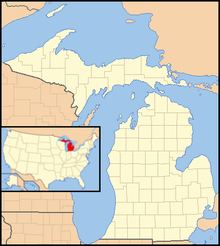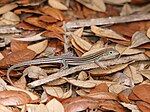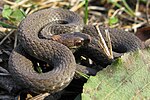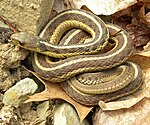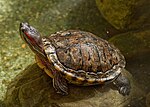
Fathom Five National Marine Park is a National Marine Conservation Area in the Georgian Bay part of Lake Huron, Ontario, Canada, that seeks to protect and display shipwrecks and lighthouses, and conserve freshwater ecosystems. Parks Canada has management plans for the aquatic and terrestrial ecosystems, with a multi-action plan for species that are at risk, including endemic species, the Monarch butterfly, the eastern ribbonsnake, and the eastern whip-poor-will. The aquatic ecosystems in the park are also of particular interest. Many fish, shellfish, amphibians, and eels are an attraction for naturalists in the park. Much of this wildlife is accessible to scuba divers and snorkellers in the park. The many shipwrecks make the park a popular scuba diving destination, and glass bottom boat tours leave Tobermory regularly, allowing tourists to see the shipwrecks without having to get wet. Additionally, there are three main popular hiking trails found within Fathom Five National Marine Park that provides visitors with views of old growth forests and the Georgian Bay. The Saugeen Ojibway Peoples have inhabited the Bruce Peninsula and the area that is now Fathom Five National Marine Park for thousands of years. This land provided for their communities and their people with the plethora of wildlife and plant life. They provide the local knowledge about Lake Huron and its ecological value to the reserve, park, and their overall livelihood. Parks Canada and Saugeen Ojibway People's collaboration is said to yield a benefit to both parties with regard to overall ecosystem knowledge.
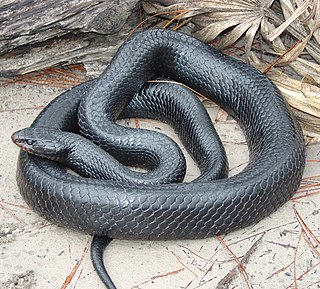
The eastern indigo snake is a species of large, non-venomous snake in the family Colubridae. Native to the southeastern region of the United States, it is the longest native snake species in North America.

The Laurentian Mixed Forest Province, also known as the North Woods, is a forested ecoregion in eastern North America. Among others, this terminology has been adopted by the Minnesota Department of Natural Resources. Similar, though not necessarily entirely identical regions, are identified by the United States Environmental Protection Agency as Northern Lakes and Forests, and by the World Wildlife Fund by regions such as the Western Great Lakes forests and Eastern forest-boreal transition.

The eastern massasauga is a rattlesnake species found in central and eastern North America from southern Ontario in Canada and throughout the Midwestern and Eastern United States. Like all rattlesnakes, it is a pit viper and is venomous.
Gibson Lake is a lake in Georgian Bay Township, District Municipality of Muskoka, Ontario, Canada. It is located 45 minutes north of the city of Barrie, and is accessed by Hwy 400 interchange # 174, just north of Six Mile Lake. Gibson Lake borders on the Wahta Mohawk Territory. The lake is 7 kilometres (4.3 mi) long, and flows into Georgian Bay via the Gibson River. The lake comprises two sections with the narrows connecting the North end to the South end. The southern areas of the lake are popular with cottagers from southern Ontario. The first cottagers purchased property here in the 1950s when the land was originally subdivided. There are presently 200 families on the lake with an increasing number of permanent residents. The north-east side of the lake is dominated by the Sahanatien Native Mohawk reserve which has seen much development in recent years. Many of the cottages on the north-east side are built on land leased from Wahta Mohawk families, and accessed by privately maintained roads.

Pantherophis vulpinus, commonly known as the eastern foxsnake or eastern fox snake, is a species of rat snake in the family Colubridae. The species is nonvenomous and is endemic to the eastern Great Lakes region of the United States, as well as adjacent western Ontario in Canada. Pantherophis gloydi is sometimes considered a distinct species and sometimes considered a junior synonym of the species Pantherophis vulpinus.

The Atlantic Plain is one of eight distinct physiographic regions of the United States. The Atlantic Plain of the United States includes portions of the coastal states of Delaware, Florida, Georgia, Maryland, Massachusetts, New Jersey, New York, North Carolina, South Carolina, and Virginia.

The New England-Acadian forests are a temperate broadleaf and mixed forest ecoregion in North America that includes a variety of habitats on the hills, mountains and plateaus of New England and New York State in the Northeastern United States, and Quebec and the Maritime Provinces of Eastern Canada.
Ecotourism in the United States is commonly practiced in protected areas such as national parks and nature reserves. The principles and behaviors of ecotourism are slowly becoming more widespread in the United States; for example, hotels in some regions strive to be more sustainable.

The Western Great Lakes forests is a terrestrial ecoregion as defined by the World Wildlife Fund. It is within the temperate broadleaf and mixed forests biome of North America. It is found in northern areas of the United States' states of Michigan, Wisconsin and Minnesota, and in southern areas of the Canadian province of Manitoba and northwestern areas of the province of Ontario.

The fauna of Louisiana is characterized by the region's low swamplands, bayous, creeks, woodlands, coastal marshlands and beaches, and barrier islands covering an estimated 20,000 square miles, corresponding to 40 percent of Louisiana's total land area. Southern Louisiana contains up to fifty percent of the wetlands found in the Continental United States, and are made up of countless bayous and creeks.
The Eastern Temperate Forests is a Level I ecoregion of North America designated by the Commission for Environmental Cooperation (CEC) in its North American Environmental Atlas. The region covers much of the Eastern and Midwestern United States, the U.S. Interior Highlands, and parts of Ontario, Quebec, and the Maritimes.
